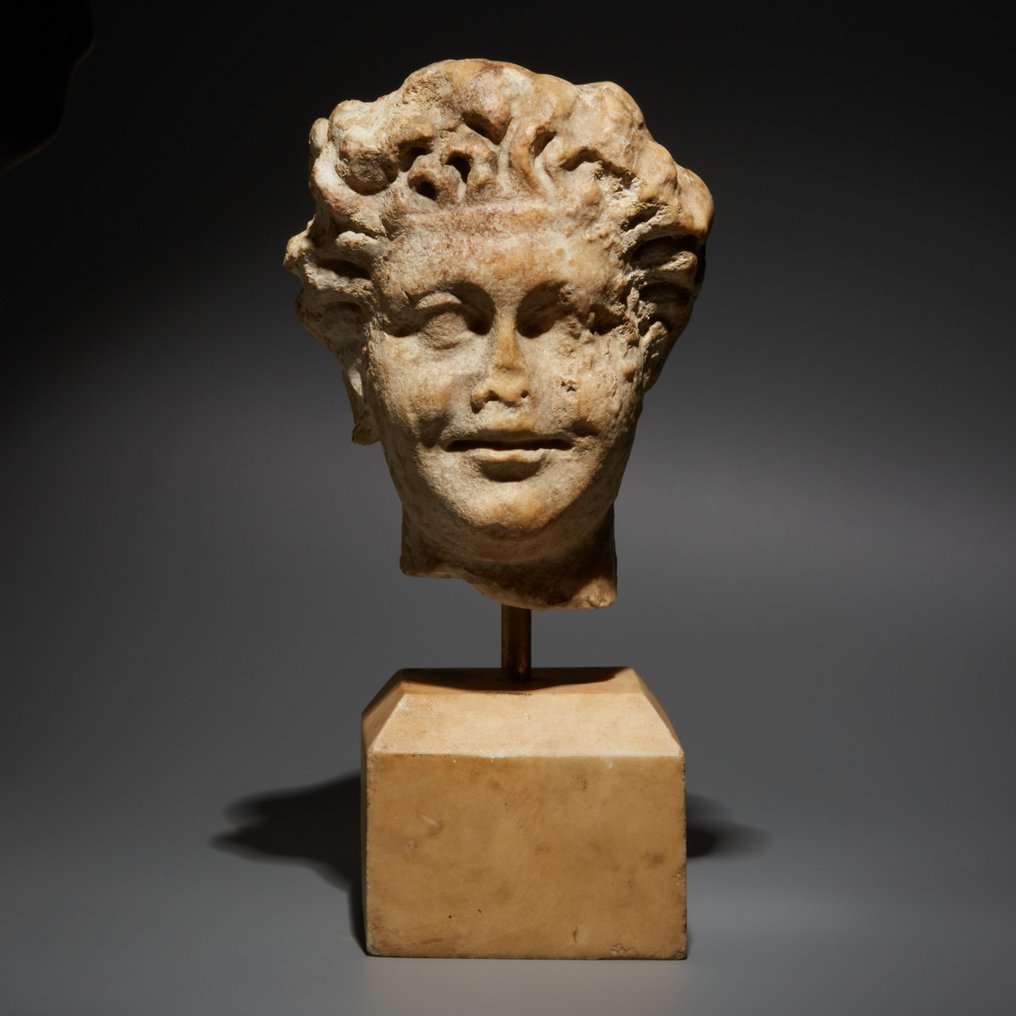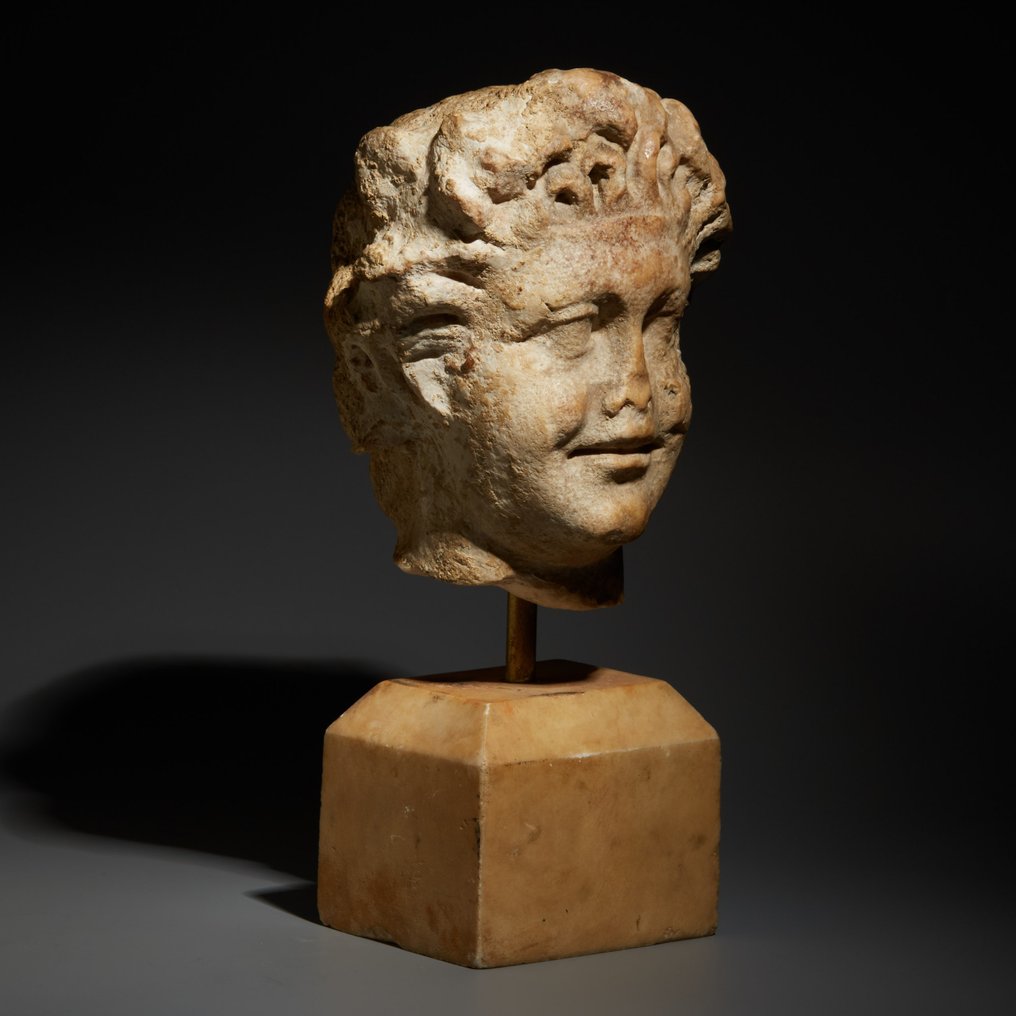Magnífica la entrega y el objeto. Perfecta la sonido del sibato
Ver traducciónAntigua Roma Mármol Bonita cabeza de sátiro o fauno. Siglo I-II d.C. 28 cm H. Licencia de Exportación Española
N.º 87317411



Nice head of a satyr or faun
Roman Empire, 1st -2nd century AD
MATERIAL: Marble
DIMENSIONS: 28 cm height with stand, 18 cm height without stand.
PROVENANCE: Private collection, Kenneth Worcester Dow, St. Augustine, Florida (USA), acquired in the 1940s.
CONDITION: Very good condition, not restorations.
DESCRIPTION:
Satyrs were related to the Maenads, and together made up the retinue of Dionysus. They can also be associated with the god Pan. Some traditions consider Silenus to be the father of the tribe of satyrs. The three principal ones were Maron, Leneus and Astraios, and as they were like their father, they are also known as Sileni. According to some versions of the myth, these three were the fathers of the other satyrs (of whom Silenus was in this instance the grandfather). The three were in the entourage of Dionysus when he travelled to India, and it was Astaios who drove his carriage.
A satyr is the equivalent of a faun in Roman mythology. A faun was a god of the fields and woods, a protector of the flocks. These he made more productive and protected from attacks by beasts of prey. Another facet of a faun was his role as an oracular god who revealed the future through voices that could be heard in the woods and in dreams: sometimes he was considered to be responsible for nightmares. He is represented as a lascivious creature, always chasing nymphs in the woods. It was also believed that he could hex peasants, and for this reason they would rub their bodies with certain herbs as a form of protection.
Although it is Roman, this piece in question follows Greek lines as does much sculpture, and therefore the iconography is that of a Greek satyr sleeping after sylvan revelry, a bacchanalia of dancing under the light of the moon. One of the most iconic images, and one of the masterpieces of classical antiquity is the Barberini Faun, one of the most important works from the school of Rhodes. The figure is sleeping, almost agonising, lying on an animal skin with both legs wide apart in an explicitly sexual posture.
Some experts maintain that the Barberini Faun is an ancient copy of a bronze original. However, the marble sculptures were always considered to be more valuable and better finished as they achieved surface textures unobtainable with cast metal, and for this reason they were painted in polychrome and kept under shelter. They appeared so real and fabulous that even after they had lost their colouring they were extremely beautiful, and so in the end the custom of leaving them unpainted prevailed.
One of the preferred motifs was the expedition of Dionysus to India accompanied by his retinue. This god was not only that of winemaking but also by extension a god of theatre and agriculture. His fundamental role, however, was that of liberating man from his preoccupations through ecstasies and ritual madness (produced by music, wine and sex). In the entourage of Dionysus we find the satyrs and bacchantes. The satyrs, confounded with the fauns, were represented as old and ugly (and could be violent and evil) until Praxiteles made them less violent and more youthful in his “Resting Satyr”. After this they began to be depicted as more beautiful figures, such as this one in question.
THE MINISTRY OF CULTURE FROM SPAIN ASKS ALL SELLERS FOR INVOICES OR OTHER DOCUMENTATION ABLE TO PROVE THE LEGALITY OF EACH ITEM BEFORE PROVIDING AN IMPORT OR EXPORT LICENSE.
Notes:
- The piece includes authenticity certificate.
- The piece includes Spanish Export License (Passport for European Union) - If the piece is destined outside the European Union a substitution of the export permit should be requested, can take between 1-2 weeks maximum.
- The seller guarantees that he acquired this piece according to all national and international laws related to the ownership of cultural property. Provenance statement seen by Catawiki.
#MasterpiecesW39
El vendedor y su historia
Nice head of a satyr or faun
Roman Empire, 1st -2nd century AD
MATERIAL: Marble
DIMENSIONS: 28 cm height with stand, 18 cm height without stand.
PROVENANCE: Private collection, Kenneth Worcester Dow, St. Augustine, Florida (USA), acquired in the 1940s.
CONDITION: Very good condition, not restorations.
DESCRIPTION:
Satyrs were related to the Maenads, and together made up the retinue of Dionysus. They can also be associated with the god Pan. Some traditions consider Silenus to be the father of the tribe of satyrs. The three principal ones were Maron, Leneus and Astraios, and as they were like their father, they are also known as Sileni. According to some versions of the myth, these three were the fathers of the other satyrs (of whom Silenus was in this instance the grandfather). The three were in the entourage of Dionysus when he travelled to India, and it was Astaios who drove his carriage.
A satyr is the equivalent of a faun in Roman mythology. A faun was a god of the fields and woods, a protector of the flocks. These he made more productive and protected from attacks by beasts of prey. Another facet of a faun was his role as an oracular god who revealed the future through voices that could be heard in the woods and in dreams: sometimes he was considered to be responsible for nightmares. He is represented as a lascivious creature, always chasing nymphs in the woods. It was also believed that he could hex peasants, and for this reason they would rub their bodies with certain herbs as a form of protection.
Although it is Roman, this piece in question follows Greek lines as does much sculpture, and therefore the iconography is that of a Greek satyr sleeping after sylvan revelry, a bacchanalia of dancing under the light of the moon. One of the most iconic images, and one of the masterpieces of classical antiquity is the Barberini Faun, one of the most important works from the school of Rhodes. The figure is sleeping, almost agonising, lying on an animal skin with both legs wide apart in an explicitly sexual posture.
Some experts maintain that the Barberini Faun is an ancient copy of a bronze original. However, the marble sculptures were always considered to be more valuable and better finished as they achieved surface textures unobtainable with cast metal, and for this reason they were painted in polychrome and kept under shelter. They appeared so real and fabulous that even after they had lost their colouring they were extremely beautiful, and so in the end the custom of leaving them unpainted prevailed.
One of the preferred motifs was the expedition of Dionysus to India accompanied by his retinue. This god was not only that of winemaking but also by extension a god of theatre and agriculture. His fundamental role, however, was that of liberating man from his preoccupations through ecstasies and ritual madness (produced by music, wine and sex). In the entourage of Dionysus we find the satyrs and bacchantes. The satyrs, confounded with the fauns, were represented as old and ugly (and could be violent and evil) until Praxiteles made them less violent and more youthful in his “Resting Satyr”. After this they began to be depicted as more beautiful figures, such as this one in question.
THE MINISTRY OF CULTURE FROM SPAIN ASKS ALL SELLERS FOR INVOICES OR OTHER DOCUMENTATION ABLE TO PROVE THE LEGALITY OF EACH ITEM BEFORE PROVIDING AN IMPORT OR EXPORT LICENSE.
Notes:
- The piece includes authenticity certificate.
- The piece includes Spanish Export License (Passport for European Union) - If the piece is destined outside the European Union a substitution of the export permit should be requested, can take between 1-2 weeks maximum.
- The seller guarantees that he acquired this piece according to all national and international laws related to the ownership of cultural property. Provenance statement seen by Catawiki.
#MasterpiecesW39
El vendedor y su historia
- 818
- 10
- 1
very well packed with all the documents included, thnks
Ver traducciónGreat object. Really beautiful. Quick delivery. Excellent.
Ver traducciónSuperbe objet, Service d'Arqueologia Ancient Art excellent et rapide. Jaume Bagot toujours parfait .
Ver traducciónTodo perfecto gracias
Ver traducciónNice item all ok A+++
Ver traducciónThank you for this Oinochoe, one question: did you as promised read my post!
Ver traducciónVery cooperative in every aspect of the transaction.
Ver traducciónAlways a great pleasure!
Ver traducciónFine quality, good service. Thanks.
Ver traducciónMuy amables, muy bien todo. Gracias
Ver traducciónAlles bestens
Ver traducciónexactly as described and shipped safely and punctually.
Ver traducciónschnelle Lieferung sehr sichere Verpackung alles bestens
Ver traduccióntres bel objet je le recherchai depuis longtemps envoi rapide et protégé je pense qu'il y aura d'autres achats avec ce vendeur merci +++++++
Ver traducciónEinfach nur toll
Ver traducciónTodo perfecto
Ver traducciónottimo
Ver traducciónperfetto
Ver traduccióntop oggetto bellissimo grazie 💯💯💯💯💯💯 :-)
Ver traducciónI bought this beautiful artifact together with artifact from Mr. Bagot but although it is clearly stated on his shipping page that when purchasing multiple artifacts i paid the double package costs
Ver traducciónI bought this beautiful artifact together with artifact from Mr. Bagot but although it is clearly stated on his shipping page that when purchasing multiple artifacts i paid the double package costs
Ver traducciónBel objet, bien emballé. Parfait.
Ver traducciónwonderful faiece and very fast shipping.thanks a lot
Ver traducciónJ Bagot es un profesional excelente. Sus artículos son de gran calidad, se incluye la documentación necesaria y el embalaje se realiza con esmero. Le recomiendo encarecidamente.
Ver traducción- 818
- 10
- 1
Magnífica la entrega y el objeto. Perfecta la sonido del sibato
Ver traducciónAviso legal
El vendedor garantiza y puede probar que el objeto ha sido obtenido legalmente. Catawiki ha informado al vendedor de que tenía que proporcionar la documentación exigida por las leyes y reglamentos de su país de residencia. El vendedor garantiza que tiene derecho a vender/exportar este objeto. El vendedor le proporcionará al comprador toda la información disponible sobre la procedencia del objeto. El vendedor garantiza que se tramitarán todos los permisos necesarios. El vendedor informará inmediatamente al comprador de cualquier retraso en la obtención de dichos permisos.
El vendedor garantiza y puede probar que el objeto ha sido obtenido legalmente. Catawiki ha informado al vendedor de que tenía que proporcionar la documentación exigida por las leyes y reglamentos de su país de residencia. El vendedor garantiza que tiene derecho a vender/exportar este objeto. El vendedor le proporcionará al comprador toda la información disponible sobre la procedencia del objeto. El vendedor garantiza que se tramitarán todos los permisos necesarios. El vendedor informará inmediatamente al comprador de cualquier retraso en la obtención de dichos permisos.









